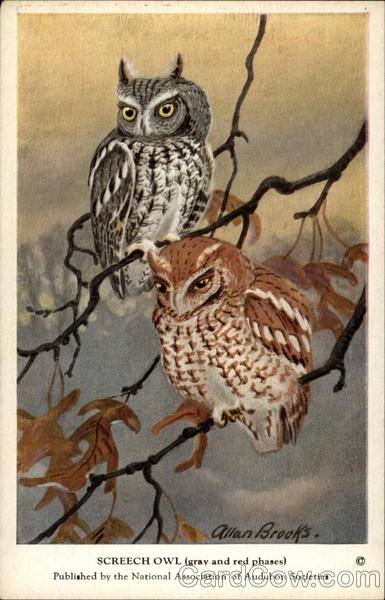Front:
Allan Broofs.
SCREECH OWL (gray and red phases)
Published by the National Association of Audubon Societies
Back:
No. 14 Screech Owl
Length 91 inches
In eastern North America the Screech Owl is
probably the best known of all the Owls. Unlike
most other members of the family, it has come to
appreciate the advantages of human neighbors,
seeking our dwellings and taking up its abode in
barns or other outbuildings. It is particularly fond
of old orchards, where it finds a most congenia!
retreat. Here it secures the small prey which con-
stitutes its food, and the Screechayl should be
regarded as a beneficial birck
"Of 255 stomachs exangihed, orady 1 contained
poultry; 38, other birds; Q1, nice $11, other mam-
mals; 2, lizards; 4, batrachtans S1, fish; 100, in-
sects; 5, spiders ; 9, crawfish ; & miscellaneous; 2,
scorpions ; 2, earthwormgi pud 43 were empty.
(Fisher.) This species is found in both gray and
brown phases of plumage which have no relation
to age, sex or season Ohe note of the Screech
Owl is a whining graver or tremulous falsetto,
which, heard in the quiet dusk of evening, has a
strange fascination
This species builds no nest, but lays its eggs in
a hole of a dead tree or a stub, frequently the cav-
ity formerly occupied by the Flicker. From four
to six white eggs are laid.
Classification: Order Raptores. Family Strigide.
Scientific name: Otus asio asio.
Range: In its different forms it is found over much
of temperate North America from southern British
Columbia to Mexico and Florida.
No. 14 from set of 50 Winter Birds of the Northeastern United
States. Published by the National Association of Audubon So-
cieties, 1974 Broadway, New York City. Price per set, in a box,
$1.00 post paid.
which, heared in greatet dusk of evening, has a



